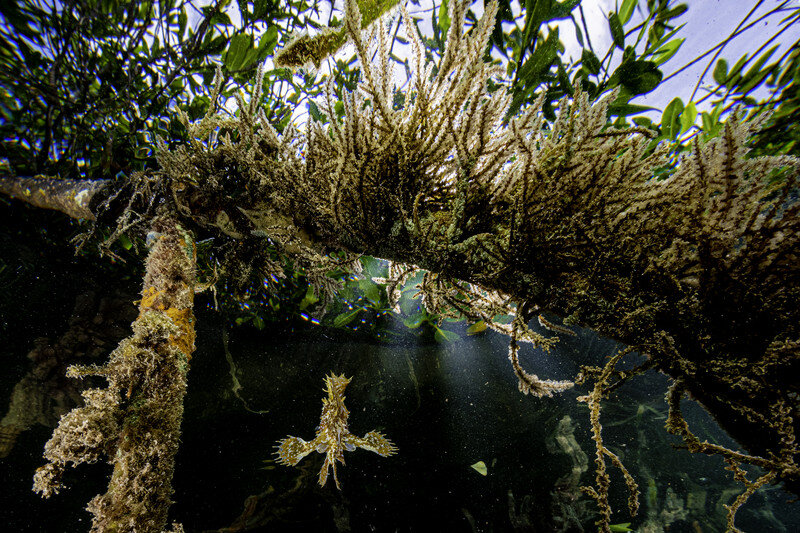© Lorenzo Mittiga
THE MANGROVES OF BONAIRE
Mangroves are rare, spectacular and prolific ecosystems on the boundary between land and sea. These extraordinary ecosystems contribute to the well being, food security, and protection of coastal communities worldwide. They support a rich biodiversity and provide a valuable nursery habitat for fish and crustaceans. Mangroves also act as a form of natural coastal defense against storm surges, tsunamis, rising sea levels and erosion. Their soils are highly effective carbon sinks, sequestering vast amounts of carbon.Yet, mangroves are disappearing three to five times faster than overall global forest losses, with serious ecological and socio-economic impacts. Current estimates indicate that mangrove coverage has been divided by two in the past 40 years.
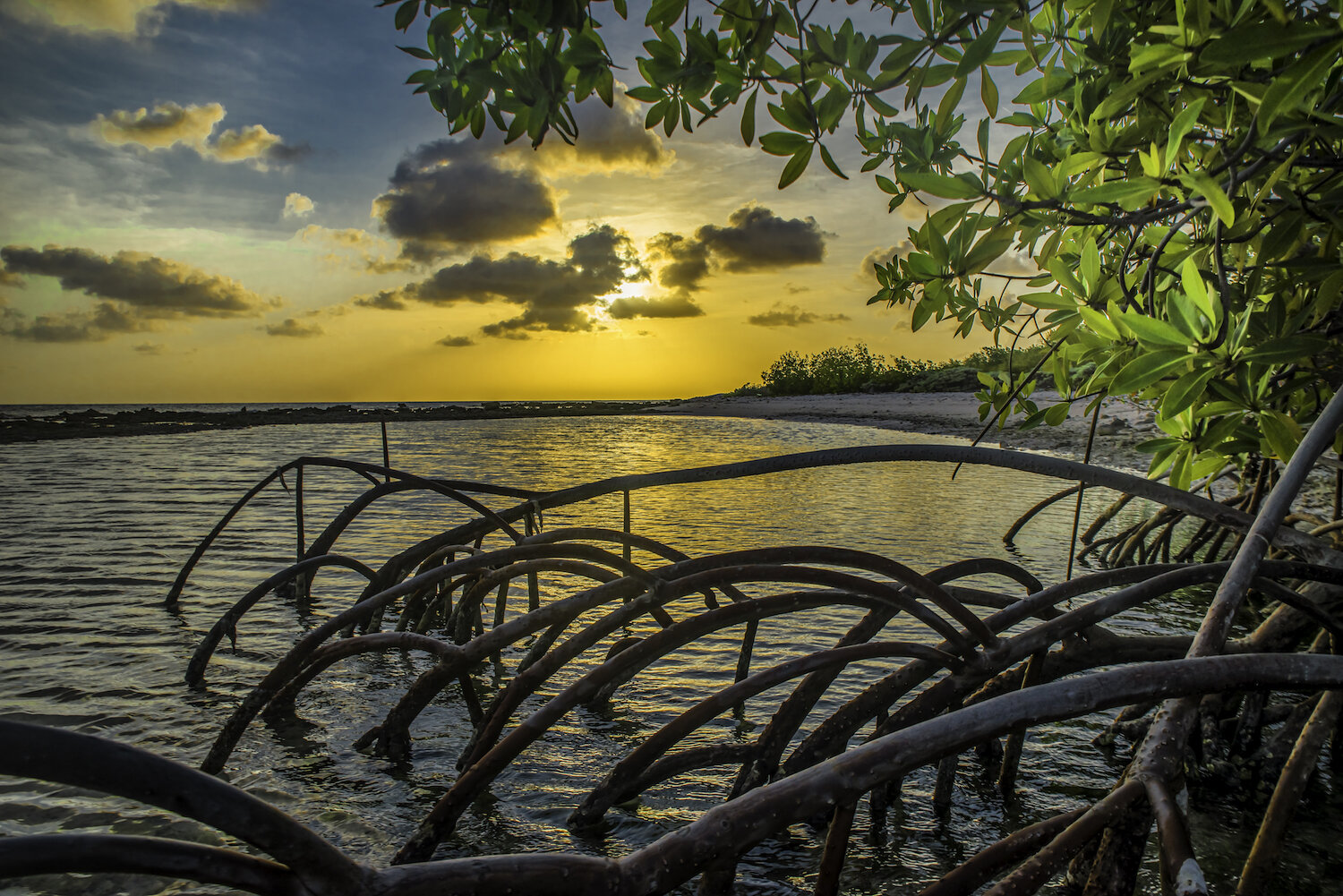
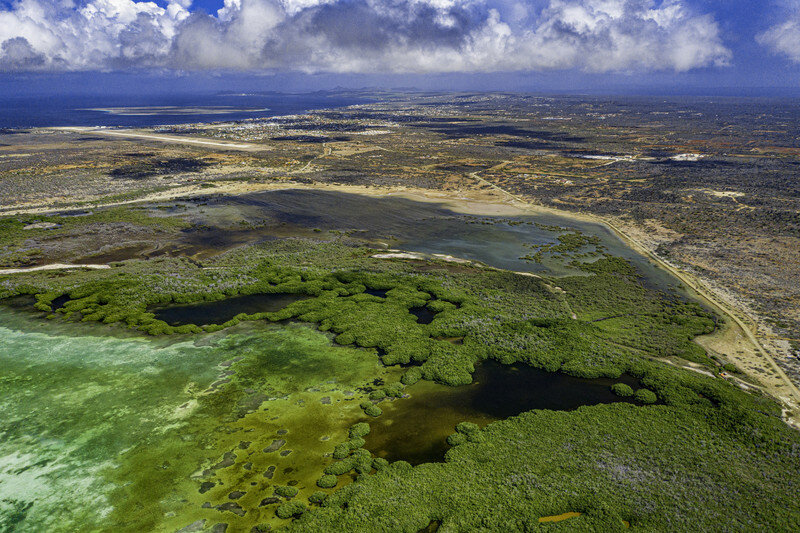

UNESCO is engaged deeply in supporting the conservation of mangroves, while advancing the sustainable development of their local communities. The inclusion of mangroves in Biosphere Reserves, World Heritage sites and UNESCO Global Geoparks contributes to improving the knowledge, management and conservation of mangrove ecosystems throughout the world.
It's almost a year that I'm working on this personal photographic conservation project with the aim to generate awareness on one of the most fragile and important habitats of the island of Bonaire. Through my photographs I'd like to show the beauty of this environment and its incredible biodiversity, hidden between the submerged roots and the aerial canopies.
As a marine biologist I knew about the importance of mangroves, but I never had the idea of exploring them “deeply in” maybe because of my wrong concept that the underwater adventures and discoveries means only “to go in the depth” and not in the shallow. I was definitely wrong. During my work, which is still in process, I've done some surprising discoveries, like the founding of invasive lionfish hiding in the submerged roots and unusual creatures as the “traveler” Sargassum frogfish, that travelled for thousands of miles to end up in the mangrove; lobster’s nurseries and resident groups of nurse sharks. The more I explore the mangroves, the more I find and give it the deserved importance.
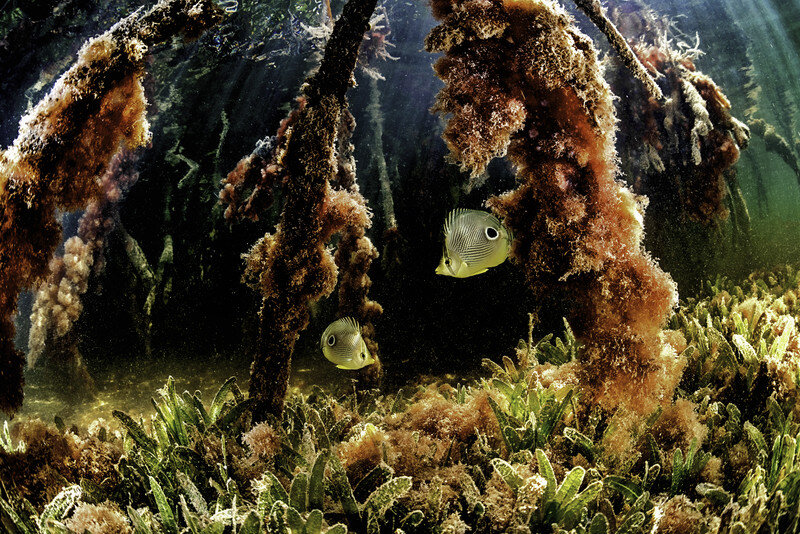

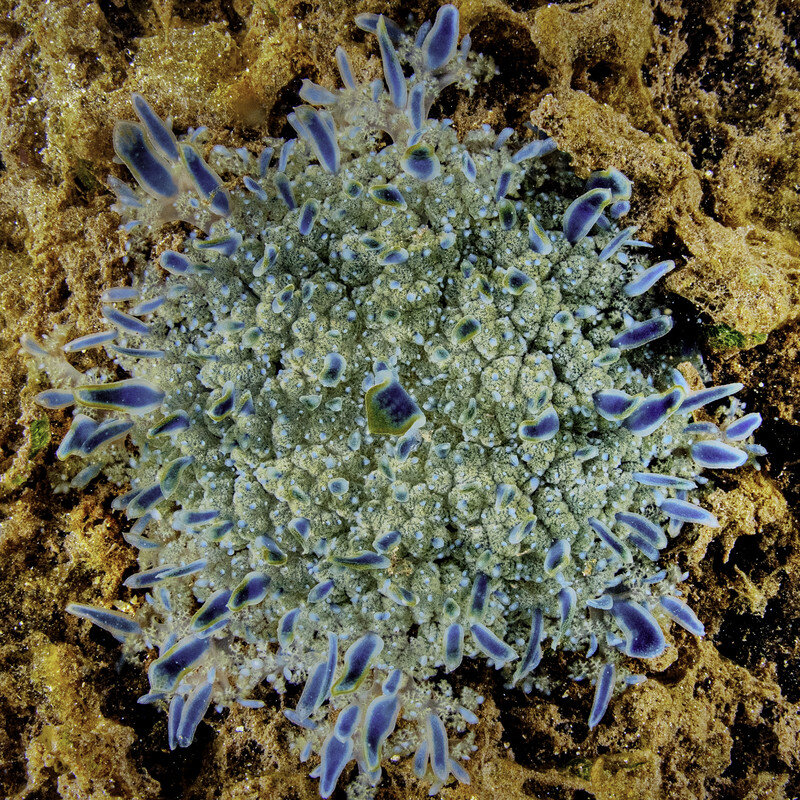
Mangroves are not just a forest in a humid and muddy place full of rats and mosquitoes: that is a misconception for most of the people.
Exploring the submerged part of the mangroves is not an easy task: the visibility is very poor and the slightest movement will lift silt and mud that will stay for long time in suspension and taking photos becomes nearly impossible; the water nearby the mangroves contains many urticant particles due to the nearby large aggregation of upside-down jelly-fish; urticant organisms and epiphytes living onto the submerged roots. It took me many expeditions (and many more to go) in order to get clear shots.
The Mangrove Ecosystem: Extreme Conditions and Extremely High Biodiversity
Mangrove forests are coastal forests and critical habitats that act as nurseries and protect from coasts from erosion.
Mangrove forests are found on coastlines in tropical and subtropical areas. The mangrove tree looks a bit strange because its roots are partially above water, making the tree look like it’s standing on many gnarly stilts. The roots are exposed to help the tree take in oxygen in a waterlogged environment. Fish, shrimp, crabs, and mollusks are among the organisms that take shelter within mangrove roots. This ecosystem is home to considerable biodiversity, but is unfortunately threatened by human activities (fishing, coastal development, trash dumping, discharged water inlets, etc.), Sargassum invasion and rising sea levels. For most of the people, mangroves are a forest with rat nests and mosquitos in muddy waters.
Exploring the submerged part of the mangroves is not an easy task: the visibility is very poor and the slightest movement will lift silt and mud that will stay for long time in suspension and taking photos becomes nearly impossible; the water nearby the mangroves contains many urticant particles due to the nearby large aggregation of upside-down jelly-fish; urticant organisms and epiphytes living onto the submerged roots. It took me many expeditions (and many more to go) in order to get clear shots.
The Mangrove Ecosystem: Extreme Conditions and Extremely High Biodiversity
Mangrove forests are coastal forests and critical habitats that act as nurseries and protect from coasts from erosion.
Mangrove forests are found on coastlines in tropical and subtropical areas. The mangrove tree looks a bit strange because its roots are partially above water, making the tree look like it’s standing on many gnarly stilts. The roots are exposed to help the tree take in oxygen in a waterlogged environment. Fish, shrimp, crabs, and mollusks are among the organisms that take shelter within mangrove roots. This ecosystem is home to considerable biodiversity, but is unfortunately threatened by human activities (fishing, coastal development, trash dumping, discharged water inlets, etc.), Sargassum invasion and rising sea levels. For most of the people, mangroves are a forest with rat nests and mosquitos in muddy waters.
Coastal Protection: Mangrove forests are able to bear the brunt of storms that hit the coast. They reduce the impact of strong waves on anything that lives further inland, including humans. Mangrove trees also protect the coast from erosion by collecting sediments from rivers and ocean tides around their roots. These sediments build up and strengthen the shoreline.


The Ocean’s Nursery: Mangrove ecosystems host a lot of biodiversity, in part due to the mangrove tree’s strange root system. The roots serve as a nursery for the larvae of many fish species, such as barracuda, tarpon, and snook. This is where fish can develop into adults before moving out to the big, unforgiving ocean. In fact, around one-third of all marine fish species are sheltered from predators in mangrove forests as juveniles.

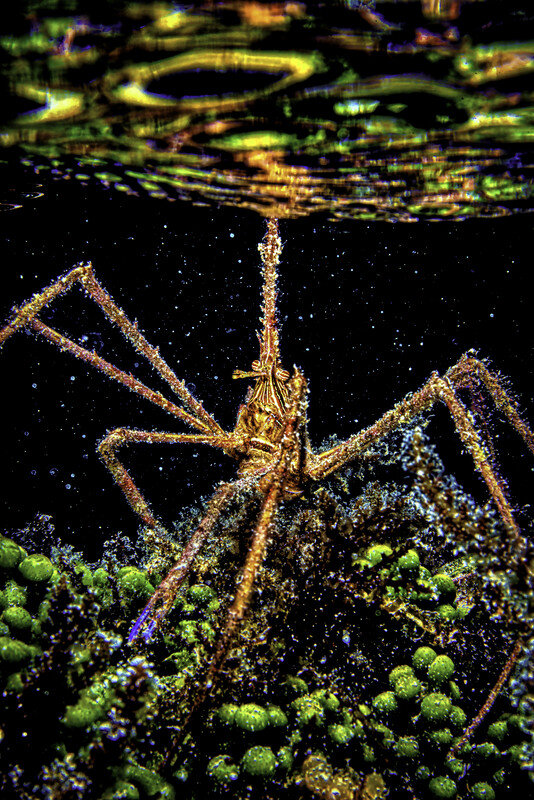
The project: Mangrove Maniacs - Bonaire Lac mangrove restoration project
A big threat is erosion land-side. The sediments make the waters in the backwaters shallower and evaporation makes water hyper saline. High salinity for red mangroves means stunted growth and eventually die-off. Black and white mangroves can handle a salinity that is a bit higher - but they also have limits. The high erosion is due to loss of vegetation by grazers - indirect human influence as humans introduced the grazers and let them roam freely.
Another threat to the mangroves is the mangroves themselves: they grow and close to water circulation. If the mangroves are in an estuary the risk is a bit less, but still there.
On Bonaire, the Dutch government funded 4 year of ecological restoration of Lac Bay as a ’nature project’ (same category are ‘Erosion control and ecological restoration’, ‘Reforestation’, ‘Coral restoration’ ‘Caves’, ‘Pig control’ and such). That funding now has stopped and each project manager had the obligation to ’safeguard’ the results of the projects. So STINAPA (the national park entity), as executor of the project, pays for part of the maintenance. The Mangrove Maniacs - Bonaire Lac restoration project is a group that has been formed during the project. The volunteers have a passion for this work (or like playing in the mud) and wanted to continue. They are supported locally. The measure of the ’success’ of hydrological restoration with the salinity and tidal connectivity (being able to measure tides in the backwaters), less smelly water, and presence of fish.
In 5 years of work 5113m channels were opened and there are 1276m still to open.
The goal of the project is to improve the biodiversity of Lac Bay and the south coastline of Bonaire by restoring hydrological conditions, protecting biodiversity and promoting sustainable tourism.
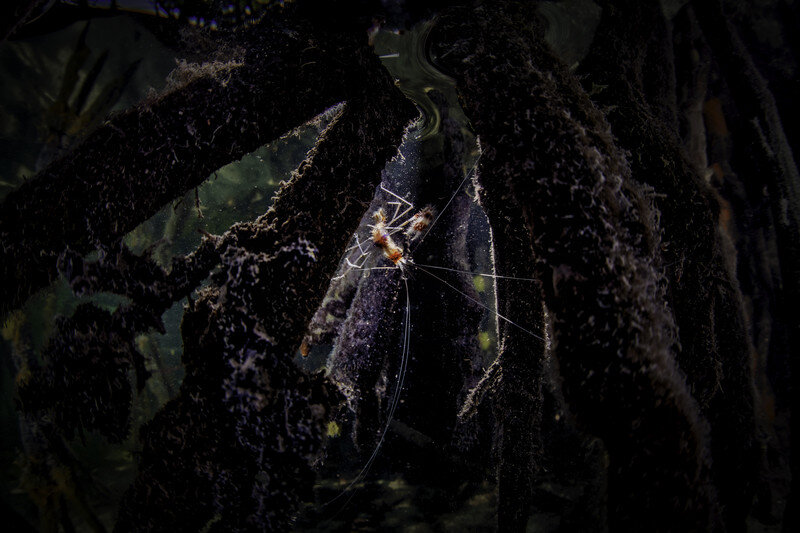
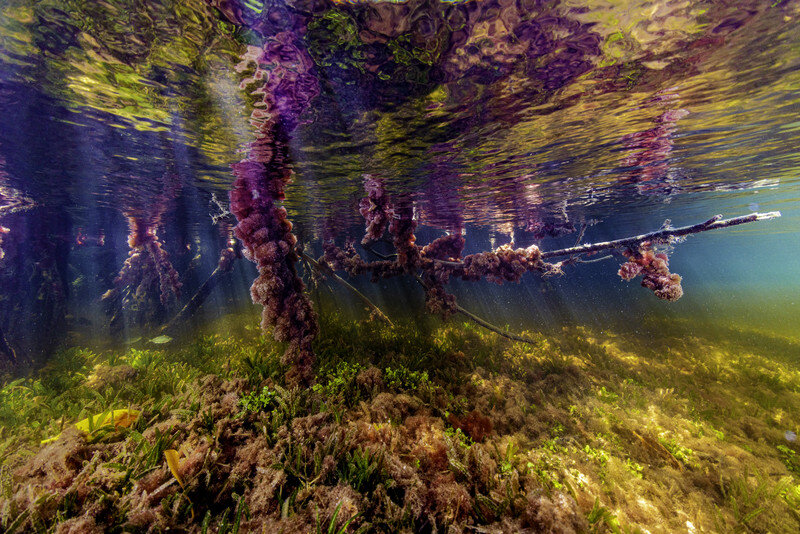
The project began in December 2015 and will continue through October 2020. The project is coordinated through the department of Spatial Planning and Development (unit Nature and Environment) of the Public Entity of Bonaire (DRO), which is working closely with the management body of Lac, STINAPA Bonaire. Important partners are Sea Turtle Conservation Bonaire (STCB) and Wild Conscience BV. Wageningen Marine Research (WMR) is providing scientific support. STINAPA is also working closely with stakeholders, notably local fishermen who have considerable knowledge of circulation patterns in Lac as well as the feeder channels (STINAPA Bonaire, 2014).
Saving and protect the mangrove's ecosystem means a lot for the nearby ocean and reef habitat as the mangroves are hosting a large variety of juvenile fish of the reef, of biodiversity and also of larger predators (such as Barracudas and sharks) that are the key for maintaining the balance of the reef.
click to view the complete set of images in the archive



